Ports In India | General Awareness - Bank Exams PDF Download
| Table of contents |

|
| Major Ports In India |

|
| Major Ports in India List |

|
| Major Ports in India Map |

|
| Major Ports in India UPSC |

|
| Important Facts About Sea Ports in India |

|
| Features of Major Ports in India |

|
Major Ports In India
Major Ports In India: India has a total of 13 major ports situated in different parts of the country. These significant ports include Ennore in Tamil Nadu, Haldia and Kolkata in West Bengal, Kandla in Gujarat, Mumbai and Jawaharlal Nehru in Maharashtra, Mangalore in Karnataka, Marmagoa in Goa, Paradip in Odisha, Tuticorin in Tamil Nadu, Visakhapatnam in Andhra Pradesh, and Kochi in Kerala.
Lakes in India
India features 13 major seaports, comprising 12 government-owned and one privately-owned port, along with over 180 smaller ports that handle substantial traffic. Mumbai Port Trust, previously known as Bombay Port Trust, manages one of India’s leading natural ports. Among the 12 government-owned ports, six are situated along the western coast, while the remaining six are located on the eastern coast of the country.
Major Ports in India List
India has 13 major seaports, with the Mumbai Port Trust being one of the largest natural ports in the country, formerly recognized as the Bombay Port Trust. Additionally, India is home to over 180 minor ports that play a substantial role in managing maritime traffic.
Check the Major Ports in India List in the table given below:
- Chennai Port (Tamil Nadu) - Major exports include rice, textile, leather, and various goods. It is located on the Eastern Coast.
- Ennore Port (Tamil Nadu) - Key exports are iron ore, petroleum, coal, and chemicals. This port is also on the Eastern Coast.
- Kolkata Port (West Bengal) - Major exports include jute, steel, and iron ore. It is situated on the Eastern Coast.
- Jawaharlal Nehru Port (Maharashtra) - This port exports textiles, chemicals, pharmaceuticals, and carpets. It is located on the Western Coast.
- Kandla Port (Gujarat) - Major exports are textiles, manganese, machinery, leather, and chemical products. It is on the Western Coast.
- Kochi Port (Kerala) - Key exports include tea, coffee, and spices. It is also situated on the Western Coast.
- Port Blair (Andaman and Nicobar Islands) - The primary export is fish. This port is in the Bay of Bengal.
- New Mangalore Port (Karnataka) - Major export is iron ore. It is located on the Western Coast.
- Mormugao Port (Goa) - Key exports include iron ore. This port is situated on the Western Coast.
- Mumbai Port (Maharashtra) - Major exports are textiles, manganese, machinery, leather, and chemical products. It is located on the Western Coast.
- Paradip Port (Odisha) - Key exports include iron ore, iron, and aluminum. It is on the Eastern Coast.
- Tuticorin Port (Tamil Nadu) - Major exports are salt, fertilizer, petroleum, and coal. This port is also on the Eastern Coast.
- Vishakhapatnam Port (Andhra Pradesh) - Major exports include coal, alumina, and oil. It is situated on the Eastern Coast.
Chennai Port
Chennai Port, formerly called Madras Port, stands as India’s second-largest container port and holds the title of being the largest port in the Bay of Bengal. This artificial port has a rich history, dating back to its opening in 1881, making it the country’s third oldest port. In 1983, it achieved the distinction of becoming India’s first dedicated container terminal. Notably, Chennai Port handles a wide range of goods, including automobiles, iron ore, coal, granite, petroleum products, and fertilizers, on a significant scale.
Ennore Port(Kamarajar Port)
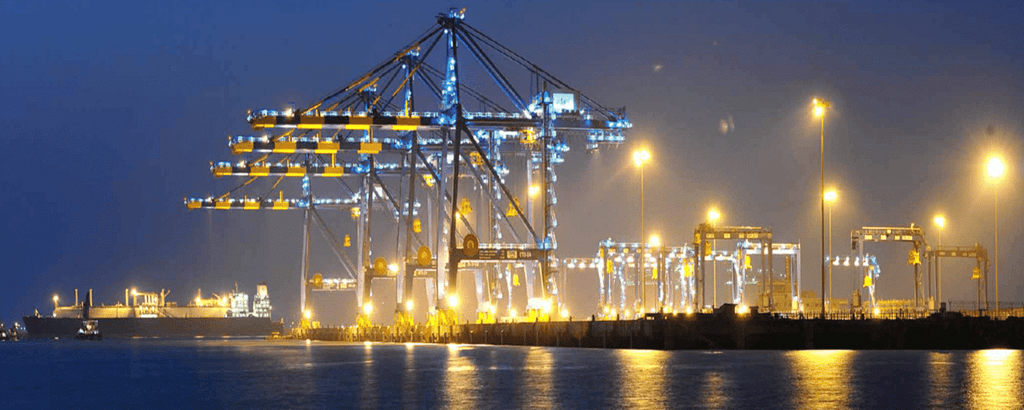
Kamarajar Port, formerly known as Ennore Port, is situated just 24 kilometers north of Chennai Port. It holds the distinction of being India’s first corporate port and is the only major port in the country that operates as a corporation. It was officially recognized as the 12th major port in India. This port is registered as a public company, with the Indian government owning a significant 67% stake in it. Kamarajar Port plays a pivotal role in transporting coal on a large scale and also handles other crucial commodities like iron ore and petroleum products.
Kolkata Port
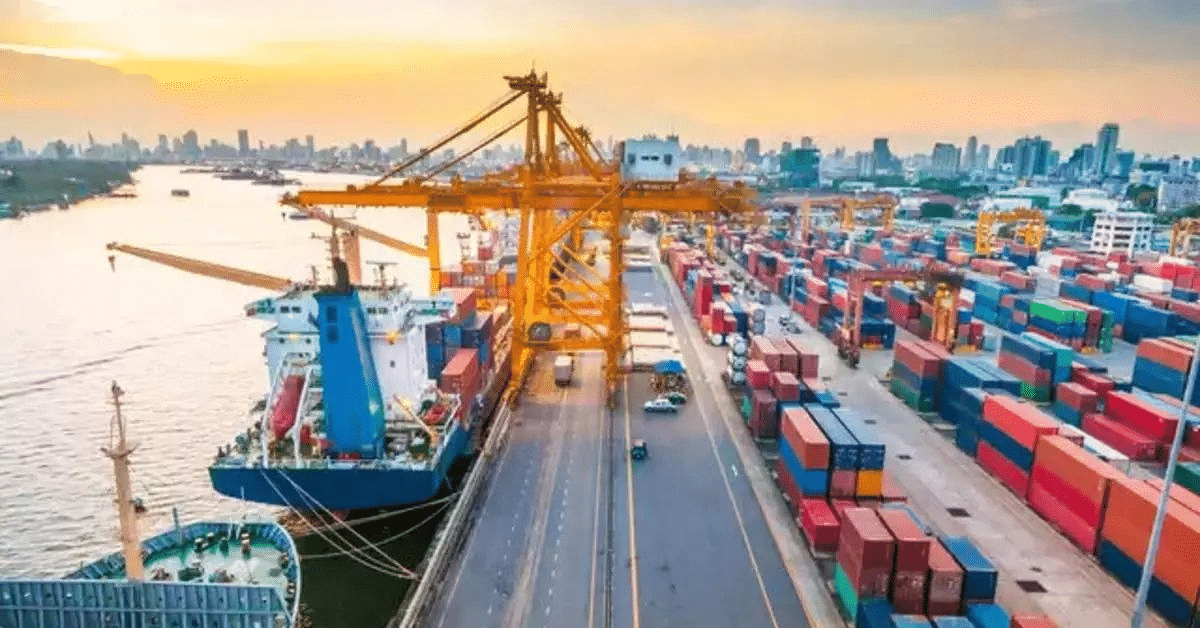
The Kolkata Port, also known as the Syama Prasad Mookerjee Port, is India’s oldest port, established by the British East India Company during the colonial era. Unlike most major ports, it’s riverine and can accommodate ships up to 500 feet in length. It operates with two docks, Haldia and Kolkata, on different banks of the River Hooghly. The port is a vital trade hub, handling exports like iron ore, leather, coal, copper, steel, and tea. Its rich history and strategic location make it a significant player in India’s maritime commerce.
Jawahar Lal Nehru Port

- Jawaharlal Nehru Port, also known as Nhava Sheva Port, is situated in Maharashtra’s Raigad district, near Navi Mumbai. It holds the title of India’s largest container-handling port, handling around 56% of the country’s containers. This port is among the busiest in India and plays a crucial role in trade.
- A variety of goods, including textiles, boneless meats, carpets, pharmaceuticals, machinery, chemicals, and vegetable oils, are transported through this port. Notably, the Western dedicated freight corridor, built by the Indian Railways, is linked to this port, enhancing its connectivity and efficiency in goods transportation.
Kandla Port
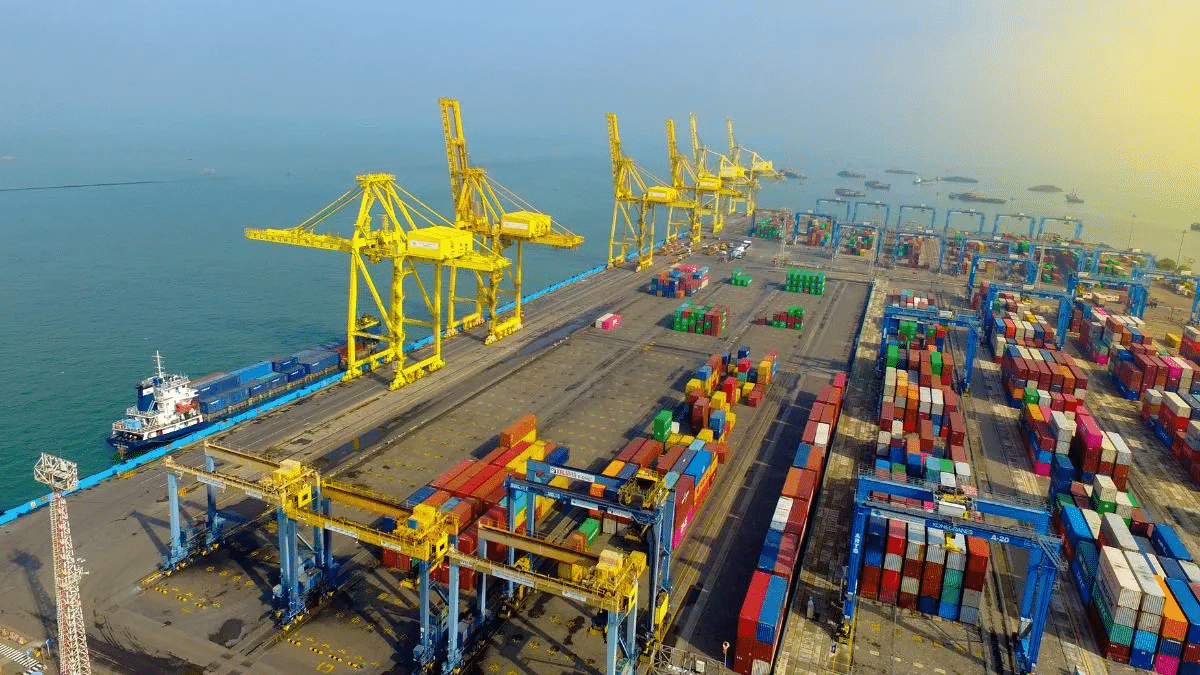
- The Kandla Port, officially called Deendayal Port, is found in Gujarat’s Kutch district, about 90 kilometers from the Gulf of Kutch. It’s India’s biggest port when it comes to handling cargo, making it one of the busiest in the country.
- A unique feature of Kandla Port is that it’s been designated as a trade-free zone. This port plays a crucial role in importing and exporting food grains, oils, machinery, petroleum products, salts, chemicals, and textiles in large quantities. It’s a vital hub for trade activities in India.
Kochi Port

- The Cochin Port, also known as the Kochi Port, is located between Willingdon Island and Vallarpadam Island in Kochi’s Lake. Within the Cochin Port lies the International Container Transshipment Terminal, also called Vallarpadam Terminal. It was India’s first transshipment terminal and remains the largest container shipment facility in the country.
- This port ranks among India’s largest and is a significant center for shipbuilding. Its primary activities involve importing and exporting goods like coffee, tea, spices, salts, and fertilizers. Cochin Port plays a crucial role in facilitating trade in the region.
Port Blair
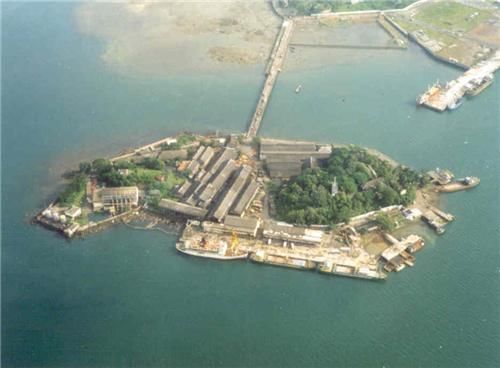
Port Blair Port Trust is a significant seaport in the Andaman and Nicobar Islands, situated along the Andaman Sea. It holds the distinction of being one of India’s major ports, managed by the Port Blair Port Trust. Interestingly, this port makes Port Blair the 13th major port in India and the sole major port in the Andaman and Nicobar Islands.
New Mangalore Port
- New Mangalore Port is located in Mangalore, Karnataka, where the River Gurupura meets the Arabian Sea. This port ranks as the seventh largest in India and is the sole major port in Karnataka. Notably, it boasts the deepest inner harbor along the eastern coast of India.
- At New Mangalore Port, you’ll find various products being handled, including petroleum products, LPG, fertilizers, and iron ore. It plays a crucial role in facilitating the transportation of these goods.
Mormugao Port
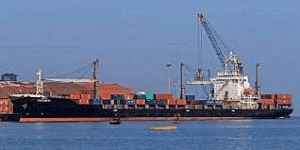
Mormugao Port sits in the estuaries of River Juari in the beautiful state of Goa, making it a notable tourist spot in the region. It holds a significant role as India’s top port for exporting iron ore. Besides iron ore, Mormugao Port also deals with commodities like cotton, manganese, and coconuts. This port is vital for trade activities and adds to Goa’s charm as a tourist destination.
Mumbai Port

- The Mumbai Port, also known as the Bombay Port, is found in Maharashtra and is a natural harbor. It holds the title of India’s largest and one of its oldest ports.
- This bustling port is the busiest in India, responsible for managing roughly one-fifth of the country’s total exports. In the harbor, you’ll also find an island called Jawahar Dweep, equipped with four jetties for handling crude and petroleum products. Moreover, the Mumbai Port boasts three dock facilities: Prince’s, Victoria, and Indira.
Paradip Port

- Paradip Port is situated in Odisha’s Jagatsinghpur district, and it holds the distinction of being the sole major port in the state. This port is strategically located where the River Mahanadi meets the Bay of Bengal.
- In 1966, Paradip Port was designated as India’s eighth major port, and it was a significant milestone as the first major port on the east coast of India commissioned after independence. The port primarily handles the transportation of essential commodities like iron ore and coal. It plays a crucial role in facilitating trade and transportation in the region.
Tuticorin Port

- The Tuticorin Port, also called the V.O. Chidambaranar Port, is situated in Tamil Nadu’s Thoothukudi district. It’s the second-largest port in the state and ranks as the fourth-largest container terminal in India.
- This port is man-made and serves as a crucial hub for trading goods to and from Sri Lanka. Once the Sethusamudram shipping canal project, aimed at creating a shipping route between India and Sri Lanka, is completed, Tuticorin Port will become India’s top port.
- Besides its trade significance, Tuticorin Port is renowned for pearl fishing in the Bay of Bengal. A variety of goods, including coal, oil, sugar, salt, and petroleum products, are handled at this busy port.
Vishakhapatnam Port

- Visakhapatnam Port, also known as Vizag Port, is situated in Visakhapatnam city, Andhra Pradesh. It’s positioned between the Chennai Port and Kolkata Port, making it a crucial maritime location.
- Vizag Port is a natural harbor and one of India’s oldest ports, known for its depth and safety. It’s the second largest in the country for cargo handling and consists of three harbors: inner, outer, and fishing.
- This port plays a vital role in transporting significant goods like iron ore, oil, coal, alumina, and pellets. Notably, it handles a substantial portion of the country’s iron exports, making it an essential hub for trade and commerce.
Major Ports in India Map
India, with its extensive coastline of approximately 7,500 kilometers, boasts a wealth of coastal areas. These coastal regions span across the country’s nine coastal states, hosting a variety of natural, artificial, and tidal ports. Among these ports, there are 13 major ones, along with 200 intermediate and minor ports. These ports play a crucial role in facilitating sea transportation and handling a substantial volume of maritime trade and traffic.
Major Ports in India UPSC
Major Ports in India” is an important subject for the UPSC IAS exam, particularly in the Geography section of the Mains General Studies Paper-1 and General Studies Paper-1 of the UPSC Prelims Syllabus. Aspirants preparing for the UPSC examination must prioritize studying Major Ports in India, as it holds paramount importance in both the Prelims and Mains exams.
Important Facts About Sea Ports in India
India’s major sea ports are crucial gateways for international trade and commerce. They are strategically located along the coastline, facilitating seamless maritime connectivity. With state-of-the-art infrastructure and modern handling systems, these ports efficiently handle diverse cargo, including containerized goods, iron ore, coal, and agricultural produce.
Some major ports like Jawaharlal Nehru Port and Chennai Port are known for their container-handling capabilities, while others like Kolkata Port and Visakhapatnam Port play pivotal roles in exporting iron ore and other commodities. These ports significantly contribute to India’s economic growth and global connectivity.
- Largest Port in India: Mumbai Port, Maharashtra
- Oldest Port in India: Syama Prasad Mookerjee Port Trust, Kolkata
- Newest Port in India: Vadhavan Port, Maharashtra
- Deepest Port in India: Visakhapatnam Port, with a natural depth greater than 16.5 meters
- Busiest Port in India: Jawaharlal Nehru Port Trust (JNPT) / Nhava Sheva Port, Maharashtra
- Private Major Port in India: Mundra Port, operated by Adani Ports and SEZ Limited (APSEZ), Gujarat
- Port with Transshipment Facility: Kochi International Container Transshipment Terminal (ICTT) / Vallarpadam Terminal of Cochin Port
Features of Major Ports in India
The Major Ports in India are vital gateways that facilitate international trade and commerce. These ports are strategically located along the vast Indian coastline, contributing significantly to the country’s economic growth. Here are some key features of these major ports:
- Location: The major ports are spread across India’s coastal regions, covering states like Kerala, Tamil Nadu, West Bengal, Gujarat, Karnataka, Goa, Maharashtra, Odisha, and Andhra Pradesh.
- Types of Ports: These major ports comprise various types, including natural ports, artificial ports, and tidal ports, each serving specific purposes.
- Cargo Handling: Major ports handle a substantial volume of cargo, ranging from essential commodities like iron ore, coal, and steel to precious items like spices, tea, and coffee.
- Infrastructure: These ports boast state-of-the-art infrastructure with modern facilities, well-equipped docks, and advanced handling systems to ensure efficient cargo operations.
- Container Handling: Many of the major ports, such as Jawaharlal Nehru Port, are major container ports, handling a significant portion of India’s container traffic.
- Economic Importance: Major ports play a crucial role in boosting the country’s export-import trade and contribute significantly to the nation’s GDP.
- Employment Generation: The ports serve as major employment hubs, providing opportunities to thousands of people in various sectors like shipping, logistics, and warehousing.
- Connectivity: These ports are well-connected to the hinterland through road and rail networks, facilitating the smooth movement of goods to and from the port areas.
- Government Ownership: Most major ports in India are owned and operated by the government, ensuring effective management and regulation of port activities.
- Trade Relations: Major ports serve as crucial links between India and various international trade partners, fostering strong trade relations and enhancing global connectivity.
|
365 videos|701 docs|149 tests
|
FAQs on Ports In India - General Awareness - Bank Exams
| 1. What are the top 5 busiest sea ports in India? |  |
| 2. How many sea ports are there in India in total? |  |
| 3. Which is the largest sea port in India? |  |
| 4. What are the major functions of sea ports in India? |  |
| 5. How does the Indian government regulate sea ports in the country? |  |





















